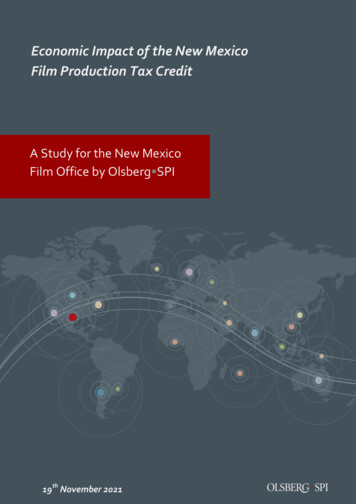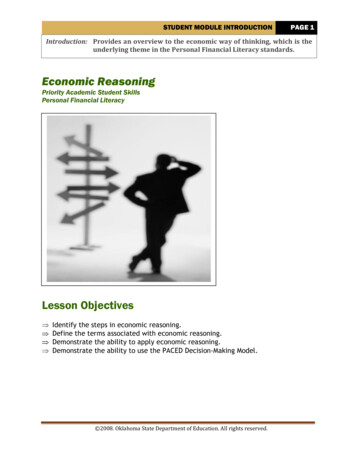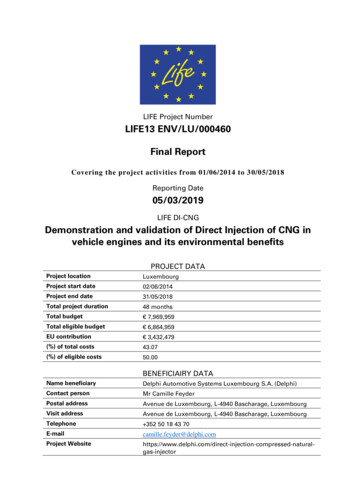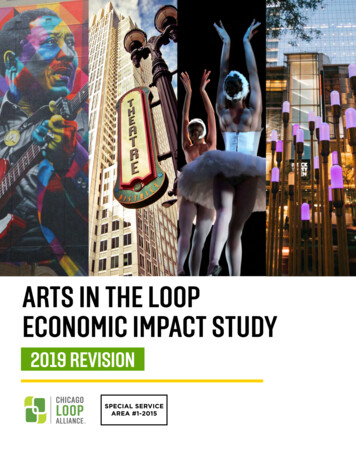
Transcription
Economic Impact of the New MexicoFilm Production Tax CreditA Study for the New MexicoFilm Office by Olsberg SPI19th November 2021
Economic Impact of the New Mexico Film Production Tax CreditContents1.Summary of Key Findings . 42.Executive Summary . 52.1.About the Study . 52.2.Context . 52.3.New Mexico Film and Television Production and Incentive Use . 62.4.Economic Impact of Production and the Tax Credit . 62.5.Wider Strategic Impacts of the Tax Credit . 72.6. Opportunities and Challenges for the Development of the Film and Television Production Sector inNew Mexico . 72.7.3.4.5.6.7.Acknowledgements . 8The Global Film and Television Production Deluge and New Mexico . 93.1.The Global Film and Television Production Deluge . 93.2.An Opportunity for New Mexico . 10New Mexico Film Production Incentives . 124.1.Background to Production Incentives . 124.2.The New Mexico Film Production Tax Credit . 124.3.The New Mexico Film Partner Program . 134.4.Film Crew Advancement Program . 134.5.Operation Soundstage . 134.6.The Giveback Program . 13New Mexico Production and Incentive Use . 155.1.Production Expenditure . 155.2.Projects . 175.3.Credit Use . 185.4.Incentive Uplifts. 185.5.Rural Activity . 195.6.Cast and Crew. 21Economic Impact of Production and the Tax Credit . 236.1.Film Sector Supply Chain. 236.2.Economic Impact . 24Wider Strategic impacts of the Tax Credit. 287.1.Film Tourism . 287.2.COVID-19 Recovery . 308. Opportunities and Challenges for the Development of the Film and Television Production Sector in NewMexico. 318.1.Opportunities for Filming in New Mexico . 318.2.Related to the Tax Credit . 318.3.Workforce Capacity and Development . 318.4.Production Infrastructure and Logistics . 328.5.Rural Uplift . 32 Olsberg SPI 202119th November 2021ii
Economic Impact of the New Mexico Film Production Tax Credit8.6.Other Uplifts. 338.7.Cultural Impact Potential. 339.Conclusions and Recommendations . 349.1.Summary . 3410. Appendix 1 – Economic Impact Methodology . 3611.Appendix 2 – Glossary . 3912. Appendix 3 – Projected Film Credit Payouts . 40 Olsberg SPI 202119th November 2021iii
Economic Impact of the New Mexico Film Production Tax Credit1. SUMMARY OF KEY FINDINGSThe Economic Importance of the New Mexico Film ProductionTax Credit 854 millionDirect economic outputof projects accessing the tax creditbetween FY20 and FY21241Separate eligible productionsaccessed the tax credit betweenFY19 and FY21 995 millionTotal Gross Value Addedgenerated by the tax creditbetween FY20 and FY21 8.40Economic return on investmentfor every dollar of tax creditoutlay Olsberg SPI 2021 160 millionProduction tax credit issuedbetween FY20 and FY21Film and television productionexpenditure ripples throughthe local economy and impactsa wide range of sectors,including those heavily affectedby the COVID-19 pandemic19th November 20214
Economic Impact of the New Mexico Film Production Tax Credit2. EXECUTIVE SUMMARY2.1.About the StudyIn May 2021, the New Mexico Film Office (“NMFO”) commissioned creative industriesconsultancy Olsberg SPI (“SPI”) to undertake an independent evaluation of the economicimpact of the New Mexico Film Production Tax Credit (the “Study”).This analysis covers standard economic impact measures, including Gross Value Added (GVA),and economic Return on Investment (RoI), as well as effects of incentivized activity on the filmand television production supply chain, the geographic impact of in-state production spending,and effects on tourism1. As overall film and television employment in New Mexico has recentlybeen calculated for the New Mexico Economic Development Department (EDD) using adifferent methodology, SPI has been asked not to include employment metrics.2 The EDD’scalculations relating to employment are appended in a separately authored document whichhas not been reviewed by SPI.Sources of data cover registration forms, film statistics forms, application forms to the NewMexico Taxation and Revenue Department, data on the disbursement of the tax credit, as wellas consultations with supported productions, legislators, vendors and other stakeholders.Due to data limitations and a change in administration, the study considers the impact sinceJuly 2019 (FY203) only.2.2.ContextIn recent years, there has been a deluge of film and television production on a global basis. Thisis driven by voracious demand for all types of content from consumer and investors alike –which include newer entrants, as well as established broadcasters and studios. Governmentsand legislators in jurisdictions of all sizes have increasingly recognized and valued theconsiderable economic and other benefits delivered by this global growth sector, especially asthey look to diversify their economies and recover from the economic effects of the COVID-19pandemic.Against this backdrop, New Mexico legislators have highlighted film and television productionas a key growth sector to diversify the state economy, with particular interest in the addedvalue and economic impact of the New Mexico Film Production Tax Credit. The details of thetax credit are summarized in the table below.Table 1Overview of the New Mexico Film Production Tax Credit4New Mexico Film Production Tax Credit: Key ElementsValue25-35% of eligible spend in state (not total spend)TypeRefundable Tax CreditCapAnnual budget of 110 million, 100 million limit on backlog. New MexicoFilm Partners (including Netflix and NBCUniversal) are exempt from cap.1Economic Return on investment is a measure of how much economic value, in terms of total GVA, is created forthe State of New Mexico for every 1 of state investment in tax credits. The economic RoI calculation removes coststo the state, including the total amount of tax credit outlay. A glossary is provided in Appendix 22Empower & Collaborate. New Mexico’s Economic Path Forward. New Mexico Economic Development Department.Prepared by the Center for Innovation Strategy & Policy @ SRI International, October 20213FY stands for Fiscal Year. FY20 is July 19 to June 2020 and FY21 runs July 20 to June 214For full information see FYI-370. New Mexico Taxation and Revenue Department. Accessible edits.pdf Olsberg SPI 202119th November 20215
Economic Impact of the New Mexico Film Production Tax CreditAlongside the tax credit, the NMFO runs a series of initiatives to support the development ofthe New Mexico crew base and encourage inward productions to invest in film and televisionproduction infrastructure in state.2.3.New Mexico Film and Television Production and Incentive UseProduction activity and expenditure in New Mexico is increasing. In FY21, expenditure reachedits highest recorded level at 623.8 million. Although the industry was restricted by COVID-19in FY20, production has shown significant resilience, rebounding back to higher than beforethe pandemic in the last financial year. While expenditure has been rising, the number ofproductions in New Mexico has fallen, reflecting rising average production budgets.Television productions make up around 60% of projects covered by the incentive, which is inline with global trends, with television series production driving a significant amount of growth.The Film Production Tax Credit program attracts significant expenditure to New Mexico. InFY20 and FY21, the estimated cost of the tax credit was 160 million, incentivizing over 920million in production expenditure.Most production activity in New Mexico is focused in urban areas in and around Albuquerqueand Santa Fe. The rural uplift attempts to incentivize rural production through the provision ofan additional 5% incentive on expenditure outside of these two main hubs. There has been agradual increase in rural production spend of 4.5 million in FY20 and 6.6 million in FY21.Nevertheless, rural spend is still only a small proportion of production – 1.1% in FY21.2.4.Economic Impact of Production and the Tax CreditProduction activity in New Mexico involves purchases and payments to a wide variety ofindustries and individuals, which impact a wide range of industrial sectors throughout thestate’s economy – including construction, hotels and real estate. During the COVID-19pandemic, when the tourism and hospitality industry in New Mexico was badly hit, film andtelevision production provided a vital source of income.Evidence from a survey of production companies and confidential consultations undertakenfor this Study indicates that the incentive is an important factor in drawing productionexpenditure to New Mexico and that very little production activity would be attracted to NewMexico without the incentive. The economic impact findings presented here reflect this highlevel of additionality.In FY20 and FY21, the total direct output associated with the production tax credit was 854million. Indirect impacts describe the impact of the uplift of activity in the supply chain andinduced effects are created as a result of the wages of those working in the production sector.When indirect and induced effects are added to this, the total output attributed to the creditover these two years is 1.39 billion.As noted, SPI has been asked not to include employment metrics, which are appended in aseparately authored document.GVA is a measure of the value that is created by economic activity, and is the differencebetween gross output and intermediate inputs. These are the goods and services utilized by anindustry in producing its gross output. SPI’s analysis using the IMPLAN economic model Olsberg SPI 202119th November 20216
Economic Impact of the New Mexico Film Production Tax Creditindicates that in FY20 and FY21, the total GVA created by the tax credit was 995 millionincluding 696 million in direct GVA (2021 prices).The economic RoI is a measure of how much economic value is created per 1 of investment intax credits by the state of New Mexico. The economic RoI calculation removes the costs to thestate, including the total amount of tax credit outlay.Overall, the tax credit program has a positive and significant economic RoI in terms of GVAcreated. Across the two years, the economic RoI is 8.4, meaning that for every 1 investedthrough the program, the benefit to the state economy is 8.40 in terms of additionaleconomic value.Table 2 displays the additional impact of the credit and accounts for deadweight. Figures arein million and rounded to the nearest 100,000.Table 2Economic impact of the NM Film Tax CreditYearOutputDirectGVAFY 20 ( million)273.1FY 21 ( dTotal46.1319.697.2672.1.2.5.Wider Strategic Impacts of the Tax CreditNew Mexico has been featured as a location in many successful films and television series thathave been produced in the state. The most notable of these has been internationallyrecognized television series Breaking Bad (2008-2013) and its prequel Better Call Saul (20152022) shot in Albuquerque and Santa Fe.The locations have benefited from being associated with the series and attracted tourists fromaround the world, with multiple Breaking Bad themed tours and merchandise. Breaking Badhas also put New Mexico on the map for other productions, with its high-quality productionproviding a very strong example of what New Mexico is able to create.The New Mexico film and television sector was able to bounce back quicker than otherindustries following COVID-19, with the NMFO’s Back2One providing guidance on how tosafely return to work, as well as protective equipment and testing.2.6.Opportunities and Challenges for the Development of the Film and TelevisionProduction Sector in New MexicoNew Mexico is regarded as a notably film-friendly state, with a favorable tax credit and asupportive legislature. The NMFO team is also highly regarded.Most supported producers and production companies responded positively when asked aboutthe administration and conditions of the tax credit, stating it has been invaluable to their Olsberg SPI 202119th November 20217
Economic Impact of the New Mexico Film Production Tax Creditprojects and productions. The state’s comparatively low living and production costs were alsonoted.A major challenge looking to the future is that New Mexico suffers from a lack of film andtelevision production workforce capacity, at all levels and roles. Where local crew exist, theyare either already committed to a project and/or are not at the level and role required – or theyare located in another part of the state. The Film Crew Advancement Program (FCAP) hasenabled many cases of crew members successfully moving up within departments. However,issues around familiarity of new inward productions with the program, as well as its applicationprocess, is limiting its potential impact.Availability of high-quality production space is a common challenge highlighted by consultees,across all sizes of production. This was particularly relevant for soundstages and postproduction facilities. There is optimism around the arrival of Netflix and potential other FilmPartners to further invest in capital projects and growth in the state’s production capacity.Crew and infrastructure capacity is currently a sectoral challenge on a global basis – and whilethese factors are certainly key challenges for future growth in New Mexico they should also beregarded as opportunities.There remains a challenge in reaching and benefiting communities outside the productionhubs of Albuquerque and Santa Fe, where the rural uplift has limited ability to cover overnightcosts.Consultees highlighted a missed opportunity for the tax credit to more effectively engage withand amplify the voices of native communities and celebrate the diversity of the state.2.7.AcknowledgementsSPI is very grateful for the assistance of Laird Graeser, NMFO, EDD, TRD, as well as consulteesand sources of data. Olsberg SPI 202119th November 20218
Economic Impact of the New Mexico Film Production Tax Credit3. THE GLOBAL FILM AND TELEVISION PRODUCTION DELUGE AND NEW MEXICO3.1.The Global Film and Television Production DelugeRecent years have seen an unprecedented deluge of film and television production in responseto voracious consumer and investor demand. In 2019, an unprecedented 177 billion was spenton the production of feature-length films ( 42.6 billion), television films, drama series anddocumentaries ( 134.4 billion).5In the US in 2019, according to calculations by UBS reported in the Economist, contentspending by 16 companies was roughly equal to the sum invested in America’s oil industry inthe same year.6This increase is being driven by streaming services such as Netflix, which is reported to haveincreased its content spend to over 17 billion in fiscal 2021.7 Other new and well capitalizedplayers have entered the market and investment from established studios and broadcastershas increased. Disney, for example, announced at its 2020 Investor Day that it expected itsglobal direct-to-consumer content expense to be between 14 billion and 16 billion dollarsacross Disney , Hulu and ESPN for fiscal 2024.8Much of the growth has been driven by television series (Figure 1), although the production offeature film has also been increasing (Figure 2).Figure 1Scripted Original Series Production in the US, 2011-202053248749520172018493455422Series 20Source: FX Networks Research5Global Screen Production – The Impact of Film and Television Production on Economic Recovery from COVID-19.Olsberg SPI, 25th June 2021. Accessible at: dies-researchand-evaluation-ly9lh6The future of entertainment. The Economist, 14th November 2019. Accessible he-future-of-entertainment7Netflix Reveals 17 Billion in Content Spending in Fiscal 2021. Variety, 20th April 2021. Accessible ontent-spend-17-billion-1234955953/8The Walt Disney Company investor day Transcript, 10th December 2020. Accessible 20/12/Disney Investor Day 2020 transcript.pdf Olsberg SPI 202119th November 20219
Economic Impact of the New Mexico Film Production Tax CreditFigure 2Worldwide Feature Film Production, 2014-2019Feature Films 201720182019Source: European Audiovisual ObservatoryGovernments of all sizes and jurisdictions have increasingly recognized and valued theconsiderable economic benefits delivered by film and television production. As a type ofspecialized and fleetfooted manufacturing activity, it creates modern, highly skilled,productive, and mobile employment. It also typically delivers an attractive return on publicinvestment alongside a variety of other economic measures. It increases inward investment,stimulates tourism, helps national branding, and enhances soft power.These economic benefits sit alongside the many cultural impacts delivered by the film andtelevision ecosystem. These benefits have been recognized for decades and have often beenthe starting point for government strategies addressing the sector.Despite initial disruption of film and television production by the COVID-19 pandemic, globalspend on film and television production and licensing of new content by streamers, studios andindependents has soared 16.4% year-on-year from 189.1 billion in 2019 to 220.2 billion in2020. Furthermore, spend is forecast to rise to 250 billion in 2021, reflecting the resilience ofthe sector and significant demand for film and television content.93.2.An Opportunity for New MexicoCompared to other US states, New Mexico has one of the lowest per capita personal incomesof US 46,338 in 2020, which ranks it 48th of the 50 US states.10 Its economy is largely based onprimary industries, such as gas and oil production, and agriculture. It also receives significantfederal spending on in-state military production and services.The current New Mexico Governor recognizes film and television production as key growthsector to diversify beyond primary industries, which are increasingly regarded as sunsetindustries, as well as increasing pressures to develop cleaner industries. In addition to this,legislators have highlighted the softer cultural impacts of film and television production, where9Streaming drove 16.4% rise in 2020 global production, licensing spend to 220bn (report). Screendaily.com, 28 thJune 2021. Accessible at: o-220bn-report/5160937.article10Source: Bureau of Economic Analysis Olsberg SPI 202119th November 202110
Economic Impact of the New Mexico Film Production Tax Creditthe production and depiction of New Mexico in film and television provides positive publicity,branding, and unique interest to inward investors and tourists generally. Olsberg SPI 202119th November 202111
Economic Impact of the New Mexico Film Production Tax Credit4. NEW MEXICO FILM PRODUCTION INCENTIVES4.1.Background to Production IncentivesIn a competitive global market where film and television production spend has reachedunprecedented levels, tax incentives have become increasingly recognized by governments asan efficient and strategic policy tool to attract and strengthen local production sectors andbuild skills, employment, and infrastructure in a future-facing global industry, as well as attracthigh-value inward investment.4.2.The New Mexico Film Production Tax CreditThe NMFO oversees the New Mexico Film Production Tax Credit and is responsible forregistrations and management, with applications and disbursements managed by the NewMexico Taxation and Revenue Department. The tax credit has changed over the last fewdecades.A tax incentive for film in New Mexico was first introduced in 2003 at a rate of 15%. The rate ofthe credit has risen over time to a base of 25%, with a maximum amount of 35% – and anadditional 5% credit for productions that are shot at least 60 miles beyond the exteriorboundaries of Bernalillo and Santa Fe Counties. The rebate can only be used on eligiblequalifying expenditure, examples of which include: Above-the-line (ATL) expenditures for New Mexico cast and crew (including wages,benefits, workers’ compensation, fringes and handling fees)Non-resident below-the-line (BTL) crew for services rendered in New Mexico(including wages, benefits, workers’ compensation, per diem, and handling fees)New Mexico expenditure for services rendered in state on set construction andoperations, set wardrobe, set accessories, set related services, photography, soundsynchronization, lighting, editing, rental of facilities and rental of equipment. 11As noted, the credit covers ATL and BTL, although there is a cap of 5 million for non-residentperforming artists and resident principal performing artists in a production.The Non-resident BTL Crew Exception (NRCE) allows for a 15% credit for the payment of wagesfor BTL crew who are not New Mexico residents.The incentive was last revised in 2019 with the Film Production Tax Credit Act coming into forcein July that year. This Act raised the annual cap of the credit to 110 million and included theadditional 5% credit for expenditure outside certain counties as specified above.Uplifts to the 25% base are also available, including an additional 5% credit for standalonepilots intended for television series in New Mexico, as well as television series productionsintended for commercial distribution with an order for at least six episodes in a single season.An additional 5% credit is also available if certain criteria are met regarding the use of qualifiedproduction facilities.Meanwhile, FCAP provides an incentive of 50% of wages for up to 1,040 hours to employersproviding on-the-job training (see Section 5.4).To qualify for the tax credit, a production must be intended for exhibition and reasonablecommercial exploitation.12 The project must be commercially viable and available to the publiceither via purchase or because media buys are in place. The project can be from a wide range11For full eligibility information see FYI-370. IbidEligibility. New Mexico Film Office webpage. Accessible at: ility/12 Olsberg SPI 202119th November 202112
Economic Impact of the New Mexico Film Production Tax Creditof genres, including feature films, television and certain commercials as well as student films,and content-based mobile apps.134.3.The New Mexico Film Partner ProgramA New Mexico Film Partner is a film production company that has made a commitment toproduce films or commercial audiovisual products in New Mexico and purchased or executed a10-year contract to lease a qualified production facility.This entitles a Film Partner to access a separate, uncapped tax credit fund, allowing 25-35% ofeligible expenditures (or costs). To date, two production companies have become FilmPartners: Netflix and NBCUniversal.This is a highly innovative program and likely pre-empts a wider industry trend for jurisdictionsto focus more on encouraging longer-term production commitments. New Mexico has earlymover advantage here, and the state has clearly been able to attract major investors.4.4.Film Crew Advancement ProgramThe Film Crew Advancement Program (FCAP) is an on-the-job training program for NewMexican residents working primarily in technical industry positions. FCAP is part of the NewMexico State’s Job Training Incentive Program (JTIP), which funds classroom and on-the-jobtraining for newly created jobs in expanding or relocating businesses for up to six months. It istherefore subject to JTIP’s 2 million cap.Independent of the 25% Film Production Tax Credit, this program serves as an incentive forparticipating companies to provide job opportunities to New Mexico residents who are readyto move up within their department or are adding a new skill set. The objective of the FCAP isto address skill gaps within local crew. Rather than bringing crew in from out of state, the FCAPencourages production companies to invest in already engaged local crew.The FCAP program provides a 50% reimbursement of qualifying participants’ wages for up to1,040 hours physically worked by the crew member. There are a range of specific criteria forboth the production company and the crew member. These include that the project budgetmust be above 200,000; post-production companies and digital production are not eligible;applications must be submitted prior to principal photography commencing; and the crewmember must work a minimum of 80 hours and a maximum of 1,040 per position.Since its implementation in FY14, 270 production companies have qualified for the FCAP,supporting a total of 3,077 participants. This includes notable productions as Breaking Bad,Roswell, and Preacher. To date, just under 20 million has been provided in reimbursement ofassociated wages.4.5.Operation SoundstageOperation Soundstage (OSS) acts as a sub-program of the FCAP, focusing on military veteransinterested in a job in the film and television industry. The OSS allows for an ad
Annual budget of 110 million, 100 million limit on backlog. New Mexico Film Partners (including Netflix and NBCUniversal) are exempt from cap. 1 Economic Return on investment is a measure of how much economic value, in terms of total GVA, is created for the State of Ne










